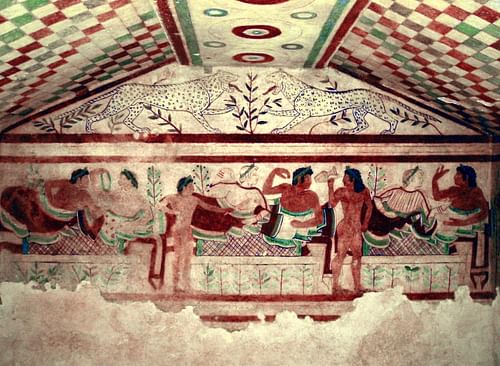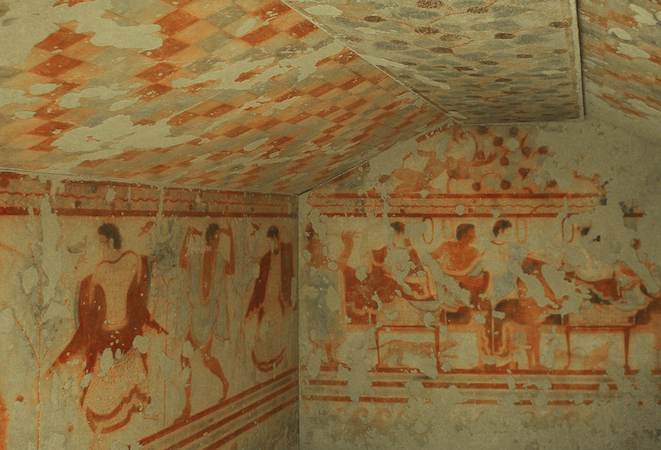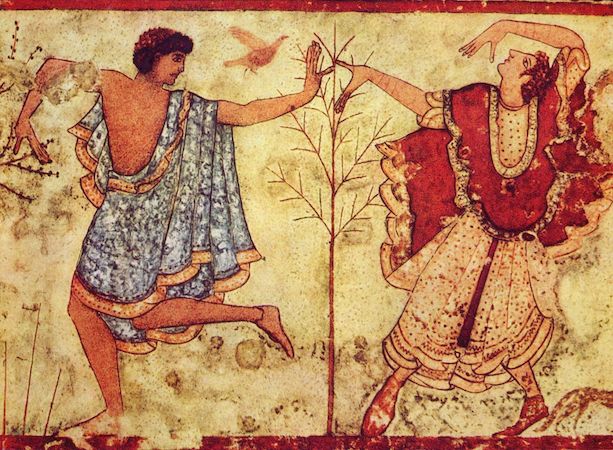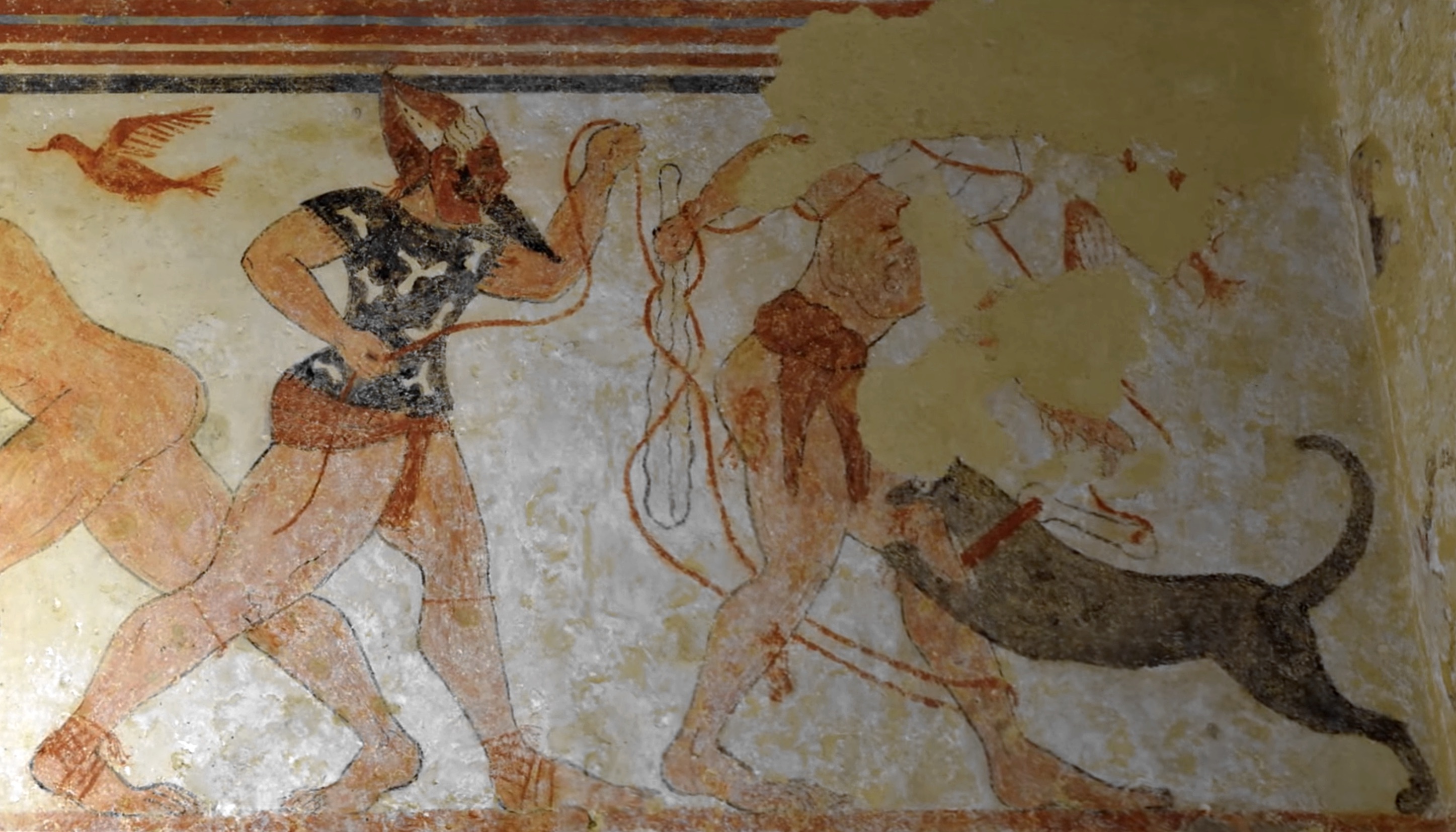The art of the Etruscans who flourished in central Italy between the 8th and 3rd century BCE is renowned for its vitality and often vivid colouring. Many surviving paintings are those on wall frescoes at burial sites.

Etruscan Tomb Paintings World History Encyclopedia
In some instances however painted terracotta panels were made separately and mounted to form an extended narrative frieze.

. As noted above his letter begins with a reference to the many Etruscan antiquities unearthed in Tuscany so many in fact that I do not wish to give an account here of everything ever found. A considerable group of Etruscan tomb-paintings dating from the middle of the sixth century show in their composition close connexion with Ionic vase-painting especially with the so-called Caeretan hydriae while their main pictures tell us something about the Etruscans themselves and their conceptions of Life and Death and Eternity. Etruscan funerary artincluding painted tombsoften depicts scenes of revelry.
In the southern part of the Etruscan empire most tombs housed sarcophagi while. Etruscan public buildings and tombs were frequently ornamented with paintings which were usually applied directly to the walls of the structure or chamber. Etruscan religion appears to have revolved around various beliefs and practices disseminated by seers and priests.
The Etruscans were isolated from other cultures. The Etruscans usually placed their dead sometimes cremated sometimes not in subterranean tombs that contained sculptures and detailed painted murals. TinTinia was the Etruscan equivalent of the Greek Zeus and Uni was his wife.
Etruscan painting technique was characterized by painting directly on fresh plaster so that the paint adhered to the plaster and thusly became part of the wall itself. Later techniques included those such as chiaroscuro which gives greater depth and value. But their activities were necessarily far more limited in scope than those taken in by the all-powerful heads of a centralized hieratic.
Tomb paintings Etruscan were funeral rites or optimistic scenes of aristocratic pleasures of----- Tomb of the Augurs in Tarquinia The figures stand on a horizontal ground line flanking the closed door leading to the underworld. The blade in your razor should be replaced. Etruscan temples also typically had three cellas and placed life-size narrative terracotta statuary on the roofs of their.
The art treasures of the Etruscans Fine arts in terracotta. Wall paintings were especially vibrant and frequently capture scenes of Etruscans enjoying themselves at parties and banquets. Figure that looked like a red blob in a 2500-year-old Etruscan tomb painting is revealed Scientists using a new technique have uncovered the colorful and once-hidden scenes in paintings of the ancient Etruscans a group of people who flourished on the Italian peninsula around 2500 years ago at a time before Rome became powerful.
The teams research is ongoing and more paintings may be revealed in the. In the much shorter-lived Etruscan civilization the wealthy citizens of the various semi-independent cities were buried in tombs where their way of living--far closer to the ordinary behavior of common people--was depicted in wall paintings. Their daughter was Menrva.
Etruscan columns were usually at the front of the building to create a deep porch while Greek columns were placed symmetrically. Etruscan tombs were. Only in the animal friezes.
Footnote 82 Adriani himself wrote to Soderini that Etruscan objects were continuously being unearthed in Tuscany no doubt from Etruscan tombs and alludes to his familiarity with them. Every level of Etruscan society had frescoes on their tombs. Etruscan painting was highly developed and used pigments created from stone and minerals.
The tomb was discovered in the 19th century but now with the new technology the painting has become much more visible. Funeral games honoring the dead were an integral part of Etruscan funerary ritual. From tomb paintings and altars we know that they believed in a variety of gods and goddesses some of whom were adopted from Greek religion.
Seen on sarcophagi and tomb paintings and Etruscan tombs are commonly likened to representations of banquets in non-funerary domestic buildings and tombs are often contexts as elucidated above indicates that the conceived of in scholarship. This shows that these roofs might corroboration between the banqueting motifs equally be compared to domestic structures.
Etruscan Tomb Paintings Ancient Man And His First Civilizations

Tomb Of The Triclinium Article Khan Academy
Etruscan Tomb Paintings Ancient Man And His First Civilizations
Etruscan Tomb Paintings Ancient Man And His First Civilizations

What Is Art For Part 9 1 The Etruscans London Fine Art Studios

The Story In Paintings Genocide And An Etruscan Tomb The Eclectic Light Company


0 comments
Post a Comment